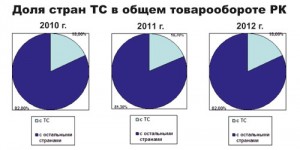 In the 1990s, President Nursultan Nazarbayev put forward initiatives for the development of Eurasian economic cooperation and integration. Today, these proposals are embodied in policy and everyday life.
In the 1990s, President Nursultan Nazarbayev put forward initiatives for the development of Eurasian economic cooperation and integration. Today, these proposals are embodied in policy and everyday life.
Kazakhstan, Russia and Belarus are promoting concerted macroeconomic actions, customs and tariff regulations and protection of their markets. The most important stages of integration, the creation of a free trade area and common customs tariffs and the establishment of a supranational authority (the Eurasian Economic Commission) and Common Economic Space have already been passed. A new scheme put forward by the heads of state will create a full-fledged Eurasian Economic Union (EEU) in 2015.
Now, Kazakhstan has approached the finish line in the creation of the Common Economic Space and has approached the accession to the World Trade Organisation. As President Nazarbayev noted at a landmark Government meeting on Oct. 11, “this is a historic event that will shape the nation’s future.”
It is necessary to quickly complete the agreement on EEU establishment, which will determine the constitutional principles and forms of the union’s activity, its structure, competence and authority.
At this stage, it may be said that the formation of a new administrative body for this economic integration effort is underway and the first fruits have already been seen. The Eurasian Economic Commission – the first supranational control body in the former Soviet space, – has been functioning since January 2012. The report of the European Bank for Reconstruction and Development – Transition Report 2012 – called the CU and the CES and their supranational bodies the first real example of regional integration in the CIS.
The potential for Eurasian integration is impressive. The total volume of CES economies, according to experts, is about 2.6 percent of the world’s GDP ($2.2 trillion) and 4 percent of world exports. Trade turnover reached $500 billion; the industrial potential is more than $600 billion; the volume of agricultural products is $112 billion. The future integration effect in terms of GDP growth for 2030 could reach $900 billion.
To make this a reality, we need concerted and synchronised efforts from both the public and private sectors.
To attain this, the three countries’ laws are being harmonised and a legal framework for the CES is being created. The main objective here is to protect member economies from negative outside influences. One of the key documents that came into effect on Jan. 1, 2013, is the Agreement on coordinated macroeconomic policies within the CES. The drafters defined methodology for socioeconomic development, the procedure for exchanging information and monitoring the economic development of participating countries, as well as a single method of calculation of macroeconomic indicators in determining the sustainability of participating countries.
These indicators include the year’s budget deficit, which must not exceed 3 percent of GDP; public debt should not be above 50 percent of GDP, while the inflation rate is permitted to exceed the inflation rate of the CES participant with the lowest index by 5 percent.
In addition, at the CES summit in Minsk on Oct. 24, the heads of state signed a decision to adopt a model law “On Competition”. In the near future, other very important CES agreements will come into force: “On Establishment of a Common Market for Crude Oil and Petroleum Products” and “On Uniform Principles and Rules of Regulation of Natural Monopolies.”
It is well known and proven by experience that even large economies such as the U.S., EU and China cannot stand in the ocean of financial and economic globalisation alone. Therefore, the implementation of coordinated macroeconomic policies will combine the potential of the CES in countering the challenges of the global crisis.
What are the initial results of Kazakhstan’s accession to the CU? Since the introduction of the Common Customs Tariff in mid-2011 both pluses and minuses have been observed in the integration process, this is natural, as integration is movement on a reciprocal track. Partners have rights and assume obligations.
First, the EEU is expected to further integrate down the road. The EEU can potentially promise large benefits through the growth of intra-regional trade, the promotion of exports of the CU to third countries and more efficient markets of goods and services.
According to the Ministry of Economy and Budget Planning of Kazakhstan, mutual trade in Kazakhstan with CU states in 2012 amounted to $24.6 billion and increased by almost 7 percent compared with the previous year. Mutual trade between Kazakhstan and Russia amounted to $24 billion (up 7 percent), with Belarus – $0.8 billion, having increased by almost 10 percent.
The share of Kazakhstan’s foreign trade with CU countries in 2012 was 18 percent, which is 0.5 percent lower compared to 2011. In the period from 2010 to 2012, the average figure was 18-20 percent. The trade structure inside the “troika” is becoming more diversified and technological. Mineral trade between CES states with third countries accounted for 73 percent, inside the CES it is 41 percent.
Second, the first step towards economic integration was made through the introduction of the Common Customs Tariff (CCT). In Kazakhstan, and to a lesser extent in Belarus, it has led to the reorientation of trade from third countries to Customs Union states. In Russia, on the contrary, an increase in trade was observed with CU countries and also with third countries, as tariff unification led to a reduction of customs tariffs for third countries.
Third, in the first years of its operation, the CU contributed significantly to the increase of common customs revenues of Kazakhstan (over 500 billion tenge). Tangible revenue growth from import duties was marked in 2010. In 2011, budget revenue increased in comparison with 2010 by $90.5 million. In general, this index in 2012 compared to 2008-2009 (before the CU) grew by 227 percent at once. This is one other argument in favour of the CES.
Fourth, according to international experts, the business climate in the three countries is gradually improving. The rating of business conditions, which is calculated by the World Bank group, was raised for CU countries (Doing Business 2013). Growing “competition amongst jurisdictions” within the CES and the expansion of choices of economic operators provide an impetus for essential increases in rankings in the future.
Fifth, after removal of tariff barriers, the volumes of Russian and Belarusian producers seen in the commodities and consumer markets of Kazakhstan increased. This can be observed in our shops.
The share of Kazakhstan’s imports from the CES rose from 32 percent in 2009 to 40 percent in 2012, of which, 38 percent consisted of Russian goods. The scale of Russian economic penetration in Kazakhstan is defined by the fact that 97 percent of Kazakhstan’s trade within the CU is with Russia.
According to the Kazakhstan Statistics Agency, in the first seven months of the current year, Kazakhstan’s imports from Russia were almost three times as high as its exports to Russia ($9.7 billion and $3.6 billion accordingly). With Belarus, this gap is eight times ($343 million and $42 million respectively). The trade deficit with Russia in the past year grew to a record level of $10.3 billion, and in the first half of this year, it reached $6.1 billion, actually equalling the 2010 figure ($6.5 billion).
These disparities arise in Kazakhstan both for objective reasons and as a result of artificial barriers. We have to admit that many of our enterprises geared towards the mass production of food and industrial products “have not landed on their feet” yet.
Another problem is subjective. It relates to the use of non-tariff regulations by our Russian and Belarusian counterparts. It is well known that goods from Kazakhstan – alcohol, meat, dairy, food and chemical products –are poorly represented in Russia and Belarus.
Kazakhstan accounts for only 7 percent of the Russian market. As President Nazarbayev noted, at first, trade in the CU has grown, and “now in our market, there are Russian and Belarusian goods.” Kazakhstan is becoming a “tax haven” for Russian businesses, because it is an open secret that our country has the softest environment for entrepreneurship in the zone, for example, the lowest VAT rate of 12 percent, while in Russia it is 18 percent and in Belarus it is 20 percent. In the current year, according to some statistics, more than nine thousand companies with ties to Russia were registered in Kazakhstan.
Sixth, Kazakhstan would like to see a new Eurasian Economic Union, not the mere unification of economic policy that serves the fortunes of business oligarchs. An extremely important task for Kazakhstan, Russia and Belarus is economic modernisation, the creation of space for breakthrough innovations and technological development based on large-scale projects. That is why in practice, Kazakhstan stands for integration through the establishment of Eurasian transnational corporations, rather than for integration through privatisation.
In turn, integration through the trans-national corporations entails a high level of technological cooperation and corporate integration between entities and companies of the CU troika, elaboration of a common trade and industrial policy of the CES and EEU aimed at improving knowledge-intensity of industrial countries – participants of the integration association, accelerated entry of the EEU economy into a new technological system and the rise of its total competitiveness. In this context, Kazakhstan is interested in establishing a CES unified patent body.
Seventh, the Eurasian Economic Commission which has been working for two years already actually is a “tri-partite government” which produces agreed decisions for each member of the CES.
The supranational body has a sufficiently broad mandate from its constituent governments that agreed to give up some of their functions for the common good. But it does not mean that the Commission can clearly dictate the “rules of the game.”
In the flow of new, accelerated global IT processes, the Eurasian commission should be highly mobile and serve as the responsible authority of collective management. It should have the best representatives member states have to offer – experienced economists, lawyers and diplomats. Actually, the commission has no right to make mistakes, because the fate of millions of ordinary people, thousands of businesses and entire sectors of the economy will largely depend on its decisions. Therefore, the main priority for the Commission, in our opinion, should be the principles of consensus and compromise.
The new principles of the four freedoms of Eurasian economic integration have been declared – the movement of goods, services, capital and human resources. We would add to them equality and equal rights.
The author is the inspector of the analytical department of the Security Council of Kazakhstan.



